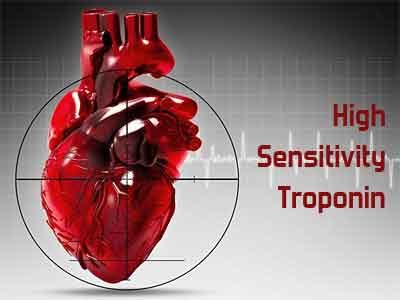- Home
- Editorial
- News
- Practice Guidelines
- Anesthesiology Guidelines
- Cancer Guidelines
- Cardiac Sciences Guidelines
- Critical Care Guidelines
- Dentistry Guidelines
- Dermatology Guidelines
- Diabetes and Endo Guidelines
- Diagnostics Guidelines
- ENT Guidelines
- Featured Practice Guidelines
- Gastroenterology Guidelines
- Geriatrics Guidelines
- Medicine Guidelines
- Nephrology Guidelines
- Neurosciences Guidelines
- Obs and Gynae Guidelines
- Ophthalmology Guidelines
- Orthopaedics Guidelines
- Paediatrics Guidelines
- Psychiatry Guidelines
- Pulmonology Guidelines
- Radiology Guidelines
- Surgery Guidelines
- Urology Guidelines
Risk stratification thresholds for high-sensitivity troponin I may speedily rule out MI with accuracy

Risk stratification thresholds for high-sensitivity cardiac troponin I may identify patients with suspected Acute Coronary Syndrome (ACS) with accuracy revealed a study published in the Journal, Circulation.
The research aimed at assessing the safety and efficacy of risk stratification thresholds in patients with the suspected acute coronary syndrome as there are various thresholds outlined in the rules recognizing the evolving role of high-sensitivity cardiac troponin for risk stratification and early rule out of myocardial infarction.
For the study, consecutive patients with the suspected acute coronary syndrome were enrolled in a multi-center trial across ten hospitals in Scotland. In a prespecified secondary and observational analysis, we compared the performance of the limit of detection (<2 ng/L) and an optimized risk stratification threshold (<5 ng/L) using the Abbott high sensitive troponin I assay. Patients with myocardial injury at presentation, with ≤ 2 hours of symptoms or with ST-segment elevation myocardial infarction were excluded. The negative predictive value (NPV) was determined in all patients and in subgroups for a primary outcome of myocardial infarction or cardiac death within 30 days. The secondary outcome was myocardial infarction or cardiac death at 12 months, with risk modeled using logistic regression adjusted for age and sex.
Key results
- In total, 32,837 consecutive patients were included, of whom 23,260 and 12,716 had cardiac troponin I concentrations <5 ng/L and <2 ng/L at presentation.
- The NPV for the primary outcome was 99.8% (95% confidence interval in those with cardiac troponin I concentrations <5 ng/L and <2 ng/L, respectively.
- At both thresholds, the NPV was consistent in men and women and across all age groups, although the proportion of patients identified as low risk fell with increasing age.
- Compared to patients with cardiac troponin I concentrations ≥5ng/L but <99th centile, the risk of myocardial infarction or cardiac death at 12 months was 77% lower in those <5 ng/L
Based on their results, the authors concluded that use of risk stratification thresholds for high-sensitivity cardiac troponin I identify patients with suspected acute coronary syndrome and at least 2 hours of symptoms as low-risk at presentation irrespective of age and sex.
For reference, follow the link
https://doi.org/10.1161/CIRCULATIONAHA.119.042866

Disclaimer: This site is primarily intended for healthcare professionals. Any content/information on this website does not replace the advice of medical and/or health professionals and should not be construed as medical/diagnostic advice/endorsement or prescription. Use of this site is subject to our terms of use, privacy policy, advertisement policy. © 2020 Minerva Medical Treatment Pvt Ltd